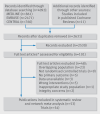Treatment strategies for women with WHO group II anovulation: systematic review and network meta-analysis
- PMID: 28143834
- PMCID: PMC5421445
- DOI: 10.1136/bmj.j138
Treatment strategies for women with WHO group II anovulation: systematic review and network meta-analysis
Erratum in
-
Treatment strategies for women with WHO group II anovulation: systematic review and network meta-analysis.BMJ. 2022 Oct 24;379:o2436. doi: 10.1136/bmj.o2436. BMJ. 2022. PMID: 36280257 Free PMC article. No abstract available.
Abstract
Objective: To compare the effectiveness of alternative first line treatment options for women with WHO group II anovulation wishing to conceive.
Design: Systematic review and network meta-analysis.
Data sources: Cochrane Central Register of Controlled Trials, Medline, and Embase, up to 11 April 2016.
Study selection: Randomised controlled trials comparing eight ovulation induction treatments in women with WHO group II anovulation: clomiphene, letrozole, metformin, clomiphene and metformin combined, tamoxifen, gonadotropins, laparoscopic ovarian drilling, and placebo or no treatment. Study quality was measured on the basis of the methodology and categories described in the Cochrane Collaboration Handbook. Pregnancy, defined preferably as clinical pregnancy, was the primary outcome; live birth, ovulation, miscarriage, and multiple pregnancy were secondary outcomes.
Results: Of 2631 titles and abstracts initially identified, 54 trials reporting on 7173 women were included. All pharmacological treatments were superior to placebo or no intervention in terms of pregnancy and ovulation. Compared with clomiphene alone, both letrozole and the combination of clomiphene and metformin showed higher pregnancy rates (odds ratio 1.69, 95% confidence interval 1.33 to 2.14; 1.71, 1.28 to 2.27; respectively). Letrozole led to higher live birth rates when compared with clomiphene alone (1.67, 1.11 to 2.49). Metformin led to lower multiple pregnancy rates compared with clomiphene alone (0.22, 0.05 to 0.93).
Conclusions: In women with WHO group II anovulation, letrozole and the combination of clomiphene and metformin are superior to clomiphene alone in terms of pregnancy. Compared with clomiphene alone, letrozole is the only treatment showing a significantly higher rate of live birth.
Systematic review registration: PROSPERO CRD42015027579.
Readers' note: This is the second version of this paper. The original version was corrected following the retraction of two studies and removal of another which were ineligible (references 40, 41, and 75 of the original paper). These studies are not shown in this version. A tracked changes version of the original version is attached as a supplementary file to the correction notice, which explains the issue further.
Published by the BMJ Publishing Group Limited. For permission to use (where not already granted under a licence) please go to http://group.bmj.com/group/rights-licensing/permissions.
Conflict of interest statement
Competing interests: All authors have completed the ICMJE uniform disclosure form at
Figures


References
-
- National Institute for Health and Care Excellence. Fertility: assessment and treatment for people with fertility problems. NICE guidance. 2013.
-
- Stein IF, Leventhal ML. Amenorrhea associated with bilateral polycystic ovaries. Am J Obstet Gynecol 1935;29:181-91 10.1016/S0002-9378(15)30642-6. - DOI
Publication types
MeSH terms
Substances
LinkOut - more resources
Full Text Sources
Other Literature Sources
Medical
Molecular Biology Databases
Miscellaneous
